Pecan Pollen Cryopreservation

Gayle M. Volk, USDA-ARS National Laboratory for Genetic Resources Preservation, 1111 S. Mason St., Fort Collins, Colorado 80521. Gayle.Volk@usda.gov
Keith Kubenka, USDA-ARS Crop Germplasm Research Unit, 2881 F&B Road, College Station, Texas 77845 Keith.Kubenka@usda.gov
L.J. Grauke, USDA-ARS Crop Germplasm Research Unit, 2881 F&B Road, College Station, Texas 77845 (retired)
Warren Chatwin, USDA-ARS Crop Germplasm Research Unit, 2881 F&B Road, College Station, Texas 77845 Warren.Chatwin@usda.gov
Ashley N. Shepherd, USDA-ARS National Laboratory for Genetic Resources Preservation, 1111 S. Mason St., Fort Collins, Colorado 80521.
Outline
- Pecan and hickory in the NPGS
- Collecting catkins
- Collecting pollen from catkins
- Moisture equilibration, packaging, and cryopreservation
- Retrieval, rehydration, and germination
- References
- Additional information
- Acknowledgments
1. Pecan and hickory in the National Plant Germplasm System (NPGS)
The USDA National Plant Germplasm System maintains the Carya (pecan and hickory) collections in the Crop Germplasm Research Unit based in College Station, Texas. The Carya orchards are located in Somerville and Brownwood, Texas. Pollen is harvested from field trees in the collection each spring for both breeding and long-term cryopreservation. This chapter describes the reproductive morphology of pecan catkins, the process of collecting Carya catkins from field-grown trees, and how pollen is separated from the catkins. After collection, pollen is either refrigerated for breeding programs or shipped to the National Laboratory for Genetic Resources Preservation (NLGRP) in Fort Collins, Colorado for further processing and long-term storage in liquid nitrogen.
2. Collecting catkins
Carya trees bear male and female reproductive organs that mature at different times, which is referred to as dichogamous. This maximizes outcrossing (cross-pollination) events. Protandrous (Type I) Carya trees bear mature catkins that shed pollen first and the female pistillate flowers are receptive later in the flowering season. Common pecan cultivars that are protandrous include ‘Pawnee’, ‘Oconee’, and ‘Western’. In contrast, protogynous (Type II) Carya trees bear female pistillate flowers that are receptive to pollen first and the catkins shed pollen later in the flowering season. Common pecan cultivars that are protogynous are ‘Kanza’ and ‘Lakota’. Protandrous trees bear catkins that are generally shorter and thicker and protogynous trees have catkins that are generally longer and thinner. Pollination charts help to ensure compatible cultivars are planted so that pollination, fertilization, and nut production occurs.
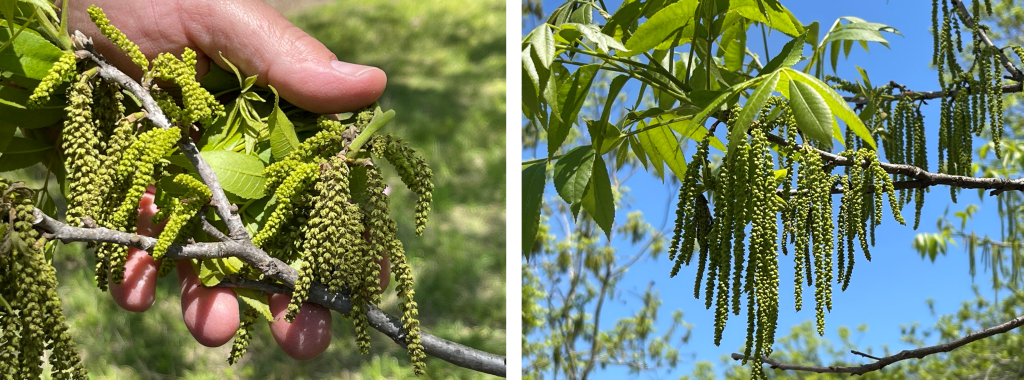
It is important to collect Carya catkins at the correct reproductive stage so that pollen will shed from the catkins after overnight desiccation. Catkin maturation occurs over several days, and catkins from a sun-exposed part of the tree often mature before those on the shady side or from within the canopy. Many catkins are collected to ensure that an adequate quantity of pollen is gathered. It might be necessary to observe the catkins with a magnifying loop to determine if pollen is being shed.
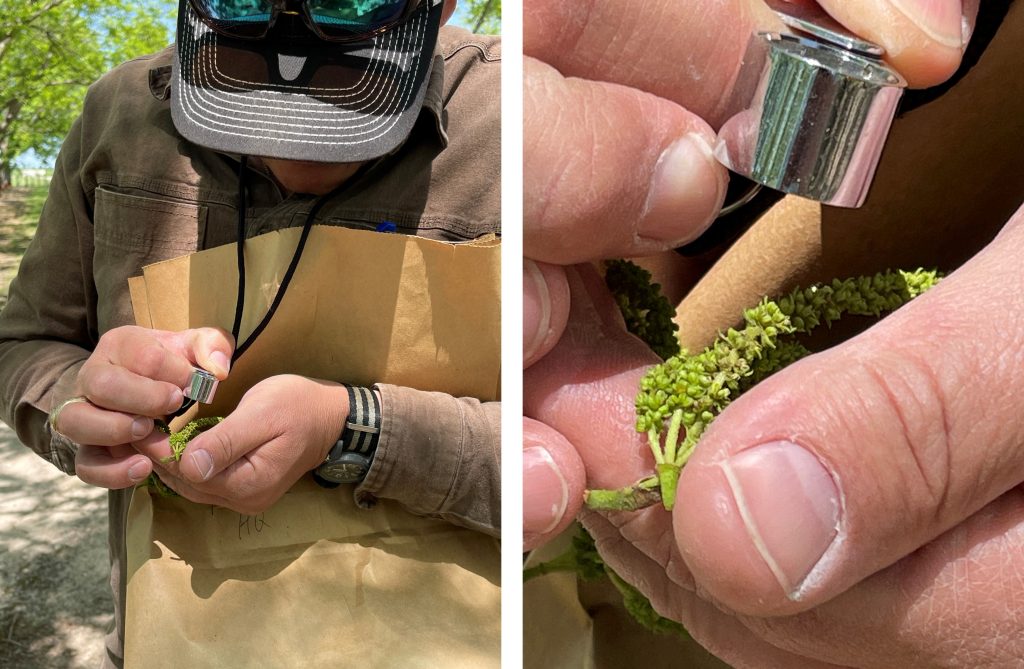
Catkins are harvested and placed into large paper bags, with approximately half-full to one full large paper bag per tree. The video below shows the process of collecting catkins from trees. Bags of harvested catkins are either immediately transferred back to the laboratory or stored in a cooler until all the trees are sampled.
3. Collecting pollen from catkins
Freshly harvested catkins are spread out in a single layer on clean white paper on tables. These should be kept in isolated spaces to prevent cross-contamination. Rooms are kept cool and dry with a dehumidifier to promote catkin desiccation and pollen release overnight. The next day, yellow pollen should be apparent on the white paper under the catkins. Additional pollen is released as the catkins are gently collected and placed in a large mesh sieve (No. 10, 2 mm opening) over the paper. The large mesh sieve is shaken by hand to release additional pollen onto the paper, separating out the larger catkin tissues. The pollen and floral parts are placed into a smaller sieve (No. 100, opening 150 µM) to purify the Carya pollen, which is then placed into 50 mL tubes and stored at 4 °C. This entire process is demonstrated in the video below.
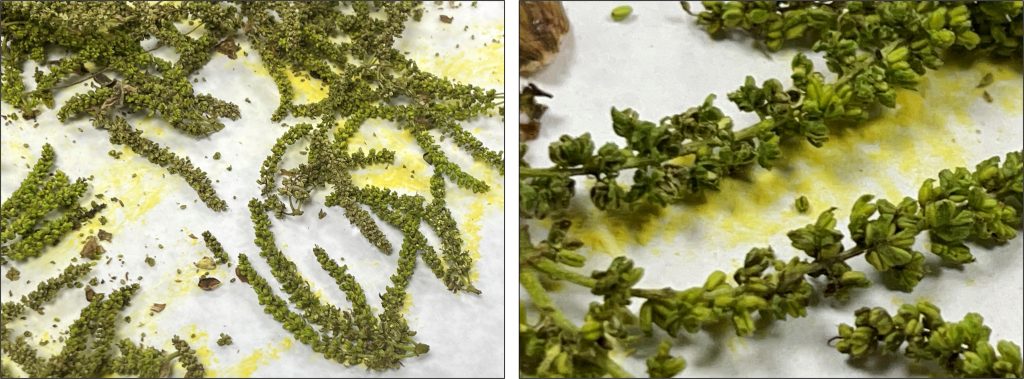

The pollen is kept at 4 °C for as long as a couple of weeks for pollinations in the breeding program. Alternatively, the pollen is immediately shipped overnight to the NLGRP in Fort Collins, Colorado for cryopreservation. The sieves are cleaned with isopropyl alcohol and water and then completely dried between samples. This will kill any residual pollen before the next use. Tabletops are wiped clean and fresh paper is used for each pollen sample.
4. Moisture equilibration, packaging, and cryopreservation
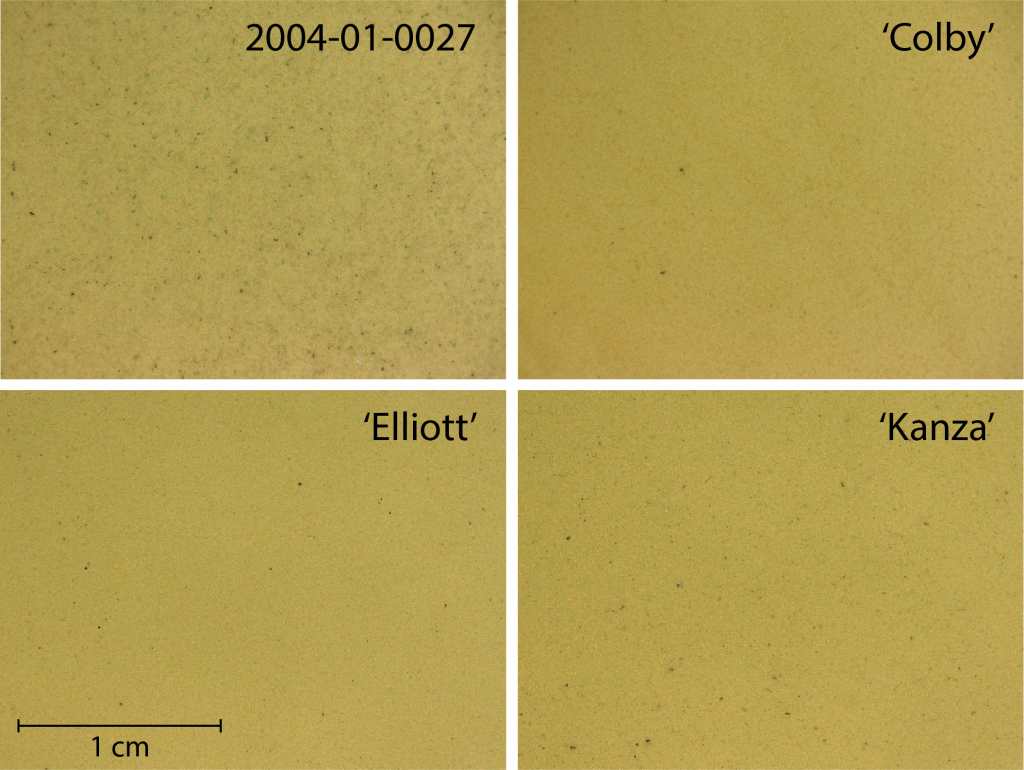
Once received at NLGRP, moisture contents are determined by weighing a small aliquot of pollen, which is then dried in an oven and reweighed after several days. The moisture content of all remaining pecan pollen is then adjusted to approximately 6-10% (fresh weigh basis). This is achieved by placing pollen into a Petri dish that is left overnight in a sealed desiccation chamber with a calcium nitrate saturated salt solution (46% relative humidity). The following day, another small aliquot of pollen is weighed, then dried in an oven and reweighed after several days. Moisture content is calculated and recorded. More information on saturated salt solutions, moisture equilibration, and moisture calculations are described in an earlier chapter.
After moisture adjustment, pollen is placed in fifteen 2 mL cryovials, which are then loaded onto canes and stored in cryocanisters in the vapor phase of liquid nitrogen in a cryotank. This allows for 15 distributions of pollen for crosses, one vial containing 2 mL of pollen per distribution. The video below shows the process of moisture adjusting, packaging, and cryopreserving pollen (note that the video shows walnut pollen, which is prepared by the same process as is pecan pollen).
5. Retrieval, rehydration, and germination
To test viability of stored material, one cryovial containing pollen must be removed from the vapor phase of liquid nitrogen, ensuring the remaining vials do not warm. The cryovial warms at room temperature (~22 °C) for 10 minutes. After pollen comes to room temperature, a very small amount of the pollen (<15 mg) is scooped from the vial and placed into a small Petri dish. The dish of pollen is set into a desiccator with a copper sulfate salt slurry solution for 4 hours to rehydrate.
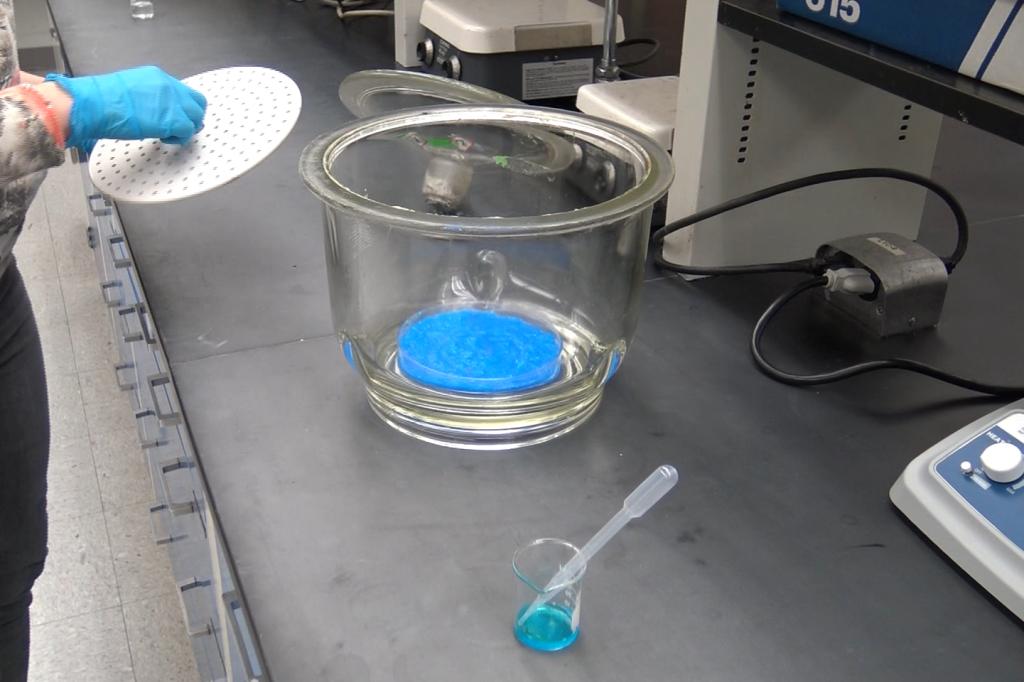
Pecan pollen viability is assessed via in vitro germination. Germination medium (15% sucrose + 0.01% boric acid + 0.03% calcium nitrate + 0.02% magnesium sulfate + 0.01% potassium nitrate + 2% agarose) is dispensed into 10 x 35 mm plastic Petri dishes in advance (Marquard, 1992). There are other published methods for pecan pollen in vitro germination, such as by Conner, 2011). To germinate pollen, the technician uses a small, soft bristled paint brush to carefully pick up a dusting of pollen with just the tips of the bristles. A very gentle tap of the brush lightly dusts pollen across the surface of the semisolid medium. Pollen should be evenly spread. The lid is placed back onto the Petri dish, which is then placed into the dark at room temperature for about 18-24 hours.
The pollen grains on the medium are observed at 200x magnification. Viability percentages are calculated by counting 100 pollen grains on each of three plates for each cryopreserved inventory. Pollen tubes longer than the diameter of the pollen grain are considered germinated. Inventories are kept in long-term preservation when the average viability of the three plates is greater than 5%. The entire recovery process, from rewarming to counting viability, is shown in the video below.
6. References
Conner PJ. 2011. Optimization of Optimization of In Vitro Pecan Pollen Germination. HortScience 46:571-576. DOI: 10.21273/HORTSCI.46.4.571
Marquard RD. 1992. Pollen Tube Growth in Carya and Temporal Influence of Pollen Deposition on Fertilization Success in Pecan. Journal of American Society of Horticulture Science 117:328-331. DOI: 10.21273/JASHS.117.2.328
7. Additional information
Download the pecan pollen cryopreservation procedure used at the NLGRP.
Download the pecan pollen recovery procedure used at the NLGRP.
8. Acknowledgments
Chapter citation: Volk GM, Kubenka K, Grauke LJ, Chatwin W, Shepherd AN. 2025. Pecan pollen cryopreservation. In: Volk GM, Chen KY (Eds.) Pollen Preservation. Fort Collins, Colorado: Colorado State University. Date accessed. Available from https://colostate.pressbooks.pub/pollenpreservation/chapter/pecan-pollen-cryopreservation/
This training module was made possible by:
Content providers: Gayle M. Volk, Keith Kubenka, L.J. Grauke, Warren Chatwin, Ashley N. Shepherd
Videographers: Gayle M. Volk, Emma Balunek, Remi Bonnart, Katheryn Y. Chen
This project was funded by the USDA-ARS and by the USDA-NIFA Higher Education Challenge Program grant 2020-70003-30930. USDA is an equal opportunity provider, employer, and lender. Mention of trade names or commercial products in this article is solely for the purpose of providing specific information and does not imply recommendation or endorsement by the U.S. Department of Agriculture.

